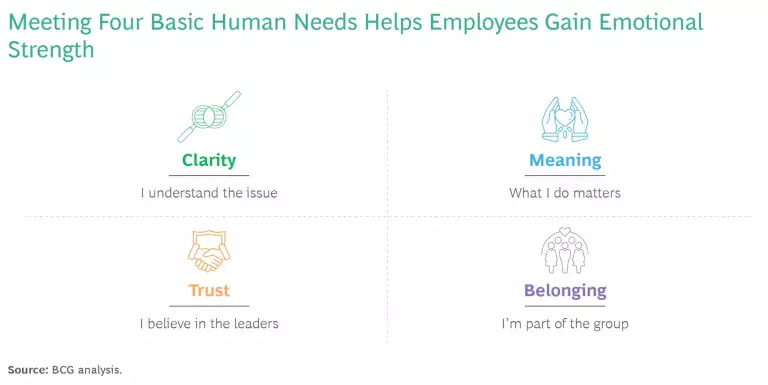A company’s biggest asset isn’t its products, brand, or real estate holdings. It’s the emotional strength of its people.
Companies need an emotionally strong workforce to withstand the ups and downs of business, a seesaw that many have experienced over the past four years. Organizations are tapping their people yet again to address financial pressures that are stemming from changing market dynamics, supply chains, and customer preferences. Such pressures also arise from the need to invest in new technologies, such as generative AI. Many companies are cutting costs to be more in line with what’s needed to stay resilient and to fund initiatives for the future.
Having an emotionally strong workforce makes it likelier that an enterprise-wide cost management initiative will succeed. But that strength doesn’t materialize out of thin air. It is the result of a company helping its people fulfill four fundamental human needs—the need for clarity, trust, meaning, and belonging. When these basic needs are met, people are better able to confront challenges and adapt to changing situations.
Companies that proactively instill emotional resilience in their people do more than create a solid workforce; they produce better outcomes than do organizations that are purely reactive. Our research shows that emotional strength lessens the impact of external shocks on employees’ performance, reduces the time it takes for them to recover, and increases the extent of that recovery.
The Four Fundamentals of Emotional Strength
Organizations can use quick pivots or drastic cost cuts to weather a financial storm or other setbacks. But those actions can be demoralizing and cause burnout, leaving the business vulnerable when the next crisis strikes. When faced with uncertainty, people worry and lose focus. They become less productive and less creative. And when people are paralyzed by fear or anxiety, it can hurt even the most well-conceived processes and strategies.
Leaders who don’t consider the emotional aspects of a cost transformation could lose the very high-performing talent they were counting on to help bring them into the future. In addition to institutional knowledge walking out the door, companies incur costly investments in recruiting, onboarding, and training talent to replace them.

Given what’s at stake, it’s plain to see the benefits of boosting the emotional strength of the workforce. Doing so requires meeting four fundamental human needs. (See the exhibit.)
The Need for Clarity. People need clarity. When a business has to change quickly, it’s easier for people to respond if they understand the issue and the actions required to address it.
Leaders can calm people’s fears about the uncertainties associated with change by focusing on what is certain, namely the company’s purpose, vision, and values. Leaders can create clarity by communicating what the company will look like in the future and how that future state builds on the organization’s past relationship with its people. At the same time, limiting the number of distinct messages, behaviors, frameworks, and principles that employees must remember and use can also help create clarity.
The Need for Trust. People need to trust that leaders have the best interests of the workforce at heart, especially during times of change. To build trust, leaders must act in a way that allows people to see them as a secure base, someone who can be counted on for direction and support. Leaders also must make people feel that they can ask questions and be heard without fear of retribution, regardless of their role or standing in the organization.
To create space for employees to have difficult or emotional conversations, leaders must actively seek feedback and gracefully acknowledge criticism. Answering people’s questions and addressing their concerns builds the kind of trust that underpins resilience. By listening, leaders also can identify and address barriers that could stand in the way of change.
The Need for Meaning. In difficult times, people need meaning to persevere through challenges and focus on goals. They need to feel that what they do matters and that they are contributing to a worthwhile cause. When employees have time to reflect on their feelings and motivations, it can help them see the value of their work, alleviate stress, and learn from their mistakes.
Focusing on a shared purpose, vision, and set of values can help the workforce shift from focusing on the problems of the past to the possibilities of the future.
Leaders can support cost transformations by connecting the personal meaning that people find in their work to the organization’s purpose , vision, and values. Leaders can use a shared purpose and set of values to guide decisions related to the transformation, explain those decisions to the workforce, and move the company toward its vision for the future. Focusing on a shared purpose, vision, and set of values can help the workforce shift from focusing on the problems of the past to the possibilities of the future.
The Need for Belonging. If meaning gives people a reason to work, belonging inspires them to work together. Belonging means feeling accepted and supported and having a shared identity. Including employees in rituals that maintain shared social structures helps foster a feeling of belonging.
Instilling a sense of belonging in the workforce is especially important during turbulent times. Faced with tough situations, employees tend to isolate themselves into familiar groups for security, which can erode trust, make people feel left out, or lead them to make mistakes as they fall into old habits. By cultivating a sense of belonging, leaders can soothe insecurities and help people feel more confident when change strikes. Part of creating a sense of belonging is communicating about what’s happening with the entire the enterprise, rather than limiting information to a select few.
Use Purpose, Vision, and Values to Build Emotional Strength
When companies fail to promote the four sources of emotional strength in a cost initiative, business turnaround, or another type of transformation, employees don’t trust the proposed solutions and aren’t aligned with the reasons for the change. They no longer feel that they are part of the organization and don’t fully understand what’s happening. Companies that implement transformations successfully are intentional about supporting people’s emotional strength. They show that support by:
- Embedding Purpose into Their Strategy and Ways of Working. Purpose is the driving force behind why an organization exists and the role it plays in the world. It serves as the foundation for a successful transformation because it inspires people to think long term instead of simply responding to the latest disruption. Leaders need to frame a transformation’s impact as being central to the company’s purpose —delivering value to stakeholders, for example, or providing societal benefit. A BCG study of close to 1,000 companies considered to be transformation leaders found that one of the top three factors that contributed to their success is a clear purpose that leaders agree on and define early in the transformation process .
- Building an Emotional Case for Change. Along with incorporating purpose into their actions, organizations must build an emotional case for change for a transformation journey. Explaining the why behind a change and setting out a clear vision of the company’s post-transformation future can help employees feel represented and that they belong, which can kindle positive attitudes toward the change. In successful transformations, employees consistently hear why changes are being made in a way that links changes to the organization’s purpose, vision, and values. Just as important, leaders can address employees’ concerns by sharing what’s not changing.
Putting Support for Emotional Strength into Practice
We’ve found that when companies’ purpose is in sync with their vision of the future, they inspire and empower their people. What’s more, the vast majority (96%) show sustained performance improvement after a transformation.
Two examples show how purpose, in particular, is not only key to fulfilling a fundamental need such as trust but also critical to leading through a crisis.
Instilling Trust. During a decade of near-constant disruption in the health care and retail industries, CVS Health used a well-established purpose of helping people to get and stay healthy to build trust among customers and employees, with lasting results.
CVS Health’s purpose-led actions started in 2014 when the company became the first US pharmacy chain to stop selling tobacco products, forgoing $2 billion in annual revenue. In the ensuing years, the company championed a nationwide antismoking campaign, targeted the use of e-cigarettes among young people, and stopped stocking sunscreen with less than an SPF of 15 as part of its stance to promote better skin health.
CVS Health continued putting purpose into practice by opening walk-in clinics to provide more accessible health care services. At the height of the COVID-19 pandemic, the company opened approximately 2,000 US testing locations and updated its website to make it easier for customers to make vaccination appointments and buy test kits.
Clear decisions made in service of its purpose have helped CVS Health consistently rank among the top 100 most admired companies and brands in the world.
A Purpose-Led Pivot. When The North Face adopted a more inclusive purpose—dare to lead the world forward through exploration—the outdoor equipment maker didn’t anticipate it would mean leading people through the early days of a global pandemic that curtailed most nonessential travel.
When initial health and safety lockdowns kept people at home, North Face leaders acted on the idea that empathy is a key component of exploration. They made an archive of exploration videos free to watch online and donated $1 million to outdoor communities. "We believe that distancing shouldn’t mean disconnection,” said Arne Arens, the president of North Face at the time. The company also donated more than 60,000 protective gloves to health care professionals and first responders.
These and other purpose-driven actions helped North Face expand its market share, attracting urban explorers who may not have been part of its customer base. A strong purpose is also a reason why North Face’s parent company, VF, has been honored by multiple organizations as a top company for diversity, equity, inclusion, ethics, and sustainability.
Business disruptions are happening more frequently, forcing companies to evolve from bracing for change to embracing it. Having an emotionally resilient workforce can speed up a transformation required to embrace change and reduce the turnover associated with it. Cultivating emotional strength requires meeting people’s essential needs for clarity, trust, meaning, and belonging. When support for people’s emotional strength is connected to purpose, vision, and values, it’s a win for the company and the workforce.









